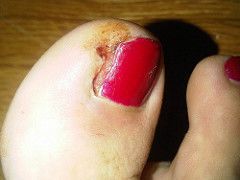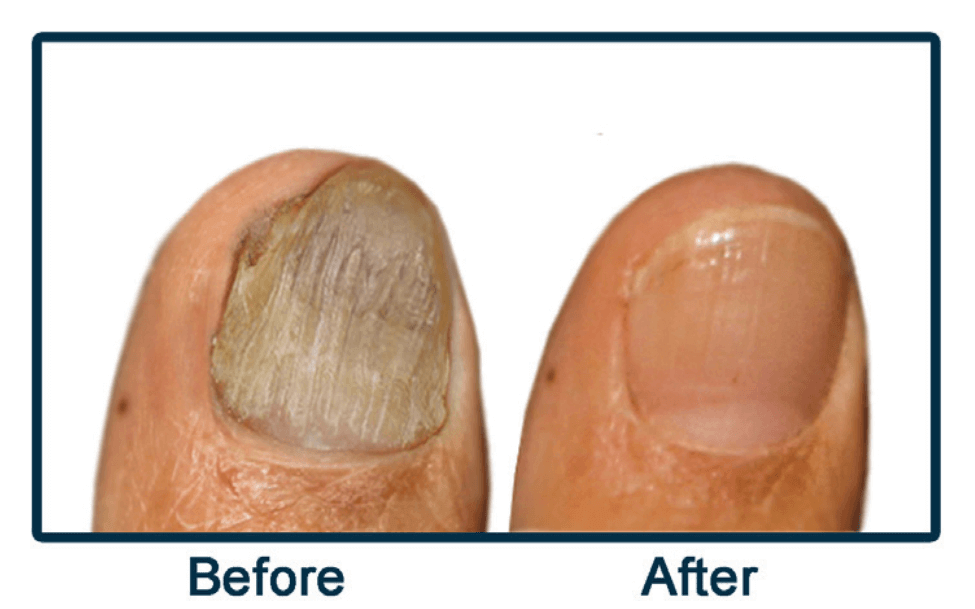Ingrown toenails can be painful annoyances with a potential for infection.
Ingrown toenails are usually caused by trimming toenails too short, most commonly on the sides of the big toes. However, this is not the only the only cause.

Ingrown toenails can be prevented by:
• Trimming toenails straight across with no rounded corners.
• Ensuring that shoes and socks are not too tight.
• Keeping feet clean at all times.
If have ever experienced an ingrown toenail you already know that early intervention is important. The level of pain, discomfort and potential for infection will increase when ingrown toenails are left untreated. Infection is more likely when the nail causes a break in the skin. This open wound allows bacteria to enter the wound and often our feet are exposed to more bacteria than other parts of our bodies. Also, our feet often spend long periods in the warm moist environments that footwear creates. This environment often contributes to discomfort and potential for infection.
Signs of an Ingrown Toenail
A toe, which is red, swollen and perhaps warm to the touch are signs that your toenail is ingrown. If you notice that your nail appears to curve downward into the skin this is a sign that your ingrown toenail can lead to infection in your toe.
Ingrown toenail treatments will depend on the severity of the condition. Many people attempt to remedy an ingrown toenail on their own and if done incorrectly bathroom surgeries often lead to infection and further complications. Initial treatments can be safely performed at home, read more information about home remedies for ingrown toenails.
Prevent Ingrown Toenails
Preventing ingrown toenails can prevent pain, infection and possible complications. Prevention begins by understanding the causes of ingrown toenails.
How to Treat an Ingrown Toenail
Most cases of ingrown toenails require intervention. Doctors Brandon Nelson DPM and Timothy Young DPM have treated ingrown toenails successfully for many years in Issaquah and have developed this resource for those suffering from ingrown toenails. If you are suffering from an ingrown toenail request an appointment today and end your pain and prevent infection.
Below is a picture of a post surgery ingrown toenail patient. The area to the left of the nail is a section of nail that has been removed. The area of skin below the portion of nail removed will change to more closely resemble “normal” skin and pain relief begins quickly.
Does this look painful?
Don’t worry!
Read about our virtually pain-free procedure for removing ingrown toenails.
Issaquah Foot & Ankle Specialists was voted as Top Doctors in Seattle!
What Is Toenail Fungus?
Toenail fungus, or onychomycosis, is an infection underneath the surface of the nail caused by fungi. When the tiny organisms take hold, the nail often becomes darker in color and smells foul. Debris may collect beneath the nail plate, white marks frequently appear on the nail plate, and the infection is capable of spreading to other toenails, the skin, or even the fingernails. If ignored, the infection can spread and possibly impair your ability to work or even walk. The resulting thicker nails are difficult to trim and make walking painful when wearing shoes. Onychomycosis can also be accompanied by a secondary bacterial or yeast infection in or about the nail plate.
Causes
Because it is difficult to avoid contact with microscopic organisms like fungi, the toenails are especially vulnerable around damp areas where you are likely to be walking barefoot, such as swimming pools, locker rooms, and showers, for example. Injury to the nail bed may make it more susceptible to all types of infection, including fungal infection. Those who suffer from chronic diseases, such as diabetes, circulatory problems, or immune-deficiency conditions, are especially prone to fungal nails. Other contributing factors may be a history of athlete's foot and excessive perspiration.
Symptoms
Toenail fungus is often ignored because the infection can be present for years without causing any pain. The disease is characterized by a progressive change in a toenail's quality and color, which is often ugly and embarrassing.
Home Treatment
A daily routine of cleansing over a period of many months may temporarily suppress mild infections. White markings that appear on the surface of the nail can be filed off, followed by the application of an over-the-counter liquid antifungal agent. However, even the best over-the-counter treatments may not prevent a fungal infection from coming back.
When to Visit a Podiatrist
You should visit a podiatrist when you notice any discoloration, thickening, or deformity of your toenails. The earlier you seek professional treatment, the greater your chance at getting your nails to clear.
Diagnosis and Treatment
Treatments may vary, depending on the nature and severity of the infection. Your podiatrist can detect a fungal infection early, culture the nail, determine the cause, and form a suitable treatment plan, which may include prescribing topical or oral medication, and debridement (removal of diseased nail matter and debris) of an infected nail.
Newer oral antifungals, approved by the Food and Drug Administration, may be the most effective treatment. They offer a shorter treatment regimen of approximately three months and improved effectiveness. Your podiatrist may also prescribe a topical treatment, which can be an effective treatment modality for fungal nails.
In some cases, surgical treatment may be required. Temporary removal of the infected nail can be performed to permit direct application of a topical antifungal. Permanent removal of a chronically painful nail that has not responded to any other treatment permits the fungal infection to be cured and prevents the return of a deformed nail.
Trying to solve the infection without the qualified help of a podiatrist can lead to more problems. With new technical advances in combination with simple preventive measures, the treatment of this lightly regarded health problem can often be successful.
Prevention
Proper hygiene and regular inspection of the feet and toes are the first lines of defense against fungal nails. Clean and dry feet resist disease.
• Wash your feet with soap and water, remembering to dry thoroughly.
• Wear shower shoes when possible in public areas.
• Change shoes, socks, or hosiery more than once daily.
• Clip toenails straight across so that the nail does not extend beyond the tip of the toe.
• Wear shoes that fit well and are made of materials that breathe.
• Avoid wearing excessively tight hosiery to decrease moisture.
• Wear socks made of synthetic fiber that “wicks” moisture away from your feet faster than cotton or wool socks do.
• Disinfect instruments used to cut nails.
• Disinfect home pedicure tools.
• Don't apply polish to nails suspected of infection (those that are discolored, for example).





